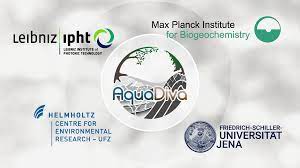- Home
- Research
- Spectroscopy and Imaging
- Projects
- Archive
- AquaDiva
AquaDiva

SFB 1076
Runtime: 01.10.2013 - 30.06.2021
The Earth's Critical Zone (CZ) is the thin zone that connects the atmosphere and geosphere. It is not only an important habitat, but is also responsible for ecosystem services, such as the provision of drinking water. Pollution, land use and climate change are increasingly altering the Earth's surface, but their impact on subsurface habitats, the part of the CZ that begins below plant roots and continues into aquifers, has not yet been adequately explored. The goal of the SFB AquaDiva is to gain a better understanding of the connections between aboveground and belowground habitats. To this end, we have established an infrastructure platform, the Hainich Critical Zone Exploratory (CZE), to explore the connectivity of vegetation and soils with aquifer complexes via water- and gas-mediated matter fluxes under different land uses. The Hainich CZE includes two aquifer complexes in limestone and marl along a 6 km transect within the influence of forest, pasture, and arable land uses. Our team combines techniques from the fields of biology, chemistry, geosciences, and computer science to answer the following questions: What organisms live there, what functions do they perform, and what is their importance to the CZ? In the first phase, biotic and chemical "fingerprints" specific to characteristics or processes of aboveground habitats were detected so that transport and transformation of such markers could be tracked as they pass down to the aquifers. Extreme events revealed unexpectedly strong spatial heterogeneity with respect to the input of water and materials to subsurface habitats. Hydrochemical data and omics-based surveys enabled the identification of distinct biogeochemical zones reflecting differences in geology, structure, solute transport, and land use of the respective infiltration zones. In the second phase, we will move from characterizing differences to explaining their origin. Linking the characterization of site conditions to biogeochemical fluxes will provide us with a deeper understanding of the ecology of subsurface habitats and the role of subsurface biota in groundwater quality. The Hainich CZE is part of an international network of Critical Zone Observatories and already has a high attractiveness for cooperation partners. We are therefore well on our way to becoming a leading international research platform in the field of biodiversity research of subterranean habitats. IPHT: We investigate how gases in soil and groundwater reflect the environmental conditions and functional biodiversity of the Critical Zone. To this end, we are (1) exploring new concepts for enhanced Raman gas spectroscopy, for simultaneous on-line quantification of a whole suite of gases in soil, (2) continuing measurement campaigns to determine temporal changes in gas compositions and isotopy in the field in the Hainich transect and sandstone sample sites, and (3) conducting controlled laboratory experiments to determine influences of microbial activity, substrate availability, etc. on patterns in the release and uptake of a variety of gases and isotopes.
The project is funded by the DFG grant under the number WLeit SFB 1076/1+2 and co-funded as a DFG-SFB.
Partners


